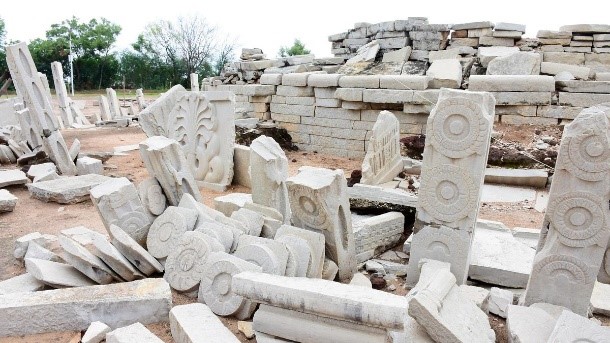Description

Disclaimer: Copyright infringement not intended.
In News
- Discovered by the ASI in the 1990s, the neglected Sannati Buddhist site underwent restoration in 2022.
Location
- The Sannati Buddhist site is situated near Kanaganahalli in Karnataka's Kalaburagi district, nestled along the banks of the Bhima river.
- Alongside its historical importance, the site is home to the revered Chandrala Parameshwari Temple.
Archaeological Discoveries
- Evidence suggests that the site underwent significant development across three distinct phases - during the Maurya, Early Satavahana, and Later Satavahana periods, spanning from the 3rd century B.C. to the 3rd century A.D.
- The expansive Ranamandala area, with its intricate remains, offers invaluable insights into both prehistoric mysteries and early historical narratives.

Inscriptions and Sculptures
- Notable findings include an inscription in the elegant Prakrit language, inscribed using the Brahmi script, shedding light on ancient linguistic and cultural practices.
- A captivating stone sculpture portraying Mauryan Emperor Ashoka, accompanied by his retinue, stands as a poignant testament to a bygone era. The inscription "Raya Asoko" unequivocally identifies the noble figure depicted.
Artifacts and Depictions
- The archaeological excavation has unearthed approximately 60 dome slabs adorned with exquisite sculptural motifs.
- These artifacts depict a rich tapestry of narratives, including timeless Jataka stories, episodes from the life of the Buddha, portraits of Shatavahana monarchs, and representations of esteemed Buddhist missionaries dispatched by Emperor Ashoka.
Educational Legacy
- Adjacent to the Sannati site lies the ancient Nagavi Ghatikasthana, renowned as the Takshashila of the South.
- This esteemed educational center flourished during the illustrious reigns of the Rashtrakuta and Kalyana Chalukya dynasties, serving as a beacon of knowledge and enlightenment between the 10th and 12th centuries.
SOURCE: THE HINDU
|
PRACTICE QUESTION
Q.Explain the impact of Buddhist principles on the development of art and architecture in ancient India. Examine the role of Buddhist monuments and artifacts in reflecting the spread and consolidation of Buddhism in the Indian subcontinent.
|















